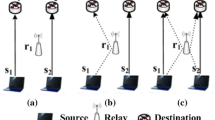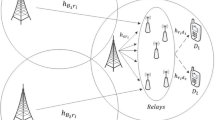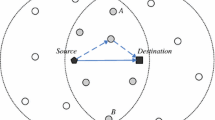Abstract
Multi-path transmission is an efficient way to balance the power consumption from a source to a destination. The previous works have studied rate–power allocation to prolong the network lifetime of multiple paths. As at least one relay node is required to participate into cooperative transmission, its assignment will greatly impact the power consumption of cooperative communication. Thus, this paper addresses the joint resource allocation problem which aims to prolong the lifetime of multi-path cooperative transmission. Given a path set from a source to a destination, we first define the lifetime-optimal relay assignment and rate–power allocation problem (LRRP) for multiple paths with cooperative communications. This paper then presents two heuristic algorithms, called BS-RRP and PS-RRP, to implement efficient resource allocation for multiple paths. The BS-RRP algorithm uses the binary search method to solve the LRRP problem on node-disjoint paths, and reaches the approximate performance 1 − ɛ, where ɛ is an arbitrarily small positive constant. PS-RRP adopts the pattern search method for joint resource allocation on link-disjoint paths, and terminates after finite iterations. The simulation results show that the BS-RRP and PS-RRP algorithms can improve the network lifetimes about 26 and 30 % compared with the resource allocation methods under the non-cooperative communication scheme.











Similar content being viewed by others
References
Xu, H., Huang, L., Qiao, C., Zhang, Y., & Sun, Q. (2012). Bandwidth-power aware cooperative multipath routing for wireless multimedia sensor networks. IEEE Transactions on Wireless Communications, 11(4), 1532–1543.
Broch, J., Johnson, D. B., & Maltz, D. A. (1999). The dynamic source routing protocol for mobile ad hoc networks. draft-ietf-manet-dsr-03.txt.
Suurballe, J. W., & Tarjan, R. E. (1984). A quick method for finding shortest pairs of disjoint paths. Networks, 14, 325–336.
Hou, Y. T., Shi, Y., & Sherali, H. D. (2004). Rate allocation in wireless sensor networks with network lifetime requirement. In Proceeding of ACM MobiHoc (pp. 67–77).
Lin, S., Zhou, G., Whitehouse, K., Wu, Y., Stankovic, J. A., & He, T. (2009). Towards stable network performance in wireless sensor networks. In Proceedings of the 30th IEEE real-time systems symposium (RTSS’09).
Srinivasan, V., Chiasserini, C. F., Nuggehalli, P. S., & Rao, R. R. (2004). Optimal rate allocation for energy-efficient multi-path routing in wireless ad hoc networks. IEEE Transaction on Wireless Communications, 3(3), 891–899.
Zhu, J., Hung, K.-L., Bensaou, B., Nait-Abdesselam, F. (2006). Tradeoff between network lifetime and fair rate allocation in wireless sensor networks with multi-path routing. In IEEE Mswim.
Chou, J., & Lin, B. (2009). Optimal multi-path routing and bandwidth alloation under utility max–min fairness. In IWQoS (pp. 1–9).
Zhang, L., Chen, S., Jian, Y., Fang, Y., & Mo, Z. (2013) Maximizing lifetime vector in wireless sensor networks. IEEE/ACM Transactions on Networking, 21(4), 1187–1200.
Zhang, L., Luo, W., Chen, S., & Jian, Y. (2012). End-to-end maxmin fairness in multihop wireless networks: Theory and protocol. Journal of Parallel and Distributed Computing, 72(3), 462–474.
Shi, Y., Sharma, S., Hou, Y. T., & Kompella, S. (2008). Optimal relay assignment for cooperative communications. In MobiHoc’08.
Elhawary, M., & Haas, Z. J. (2011). Energy-efficient protocol for cooperative networks. IEEE/ACM Transactions on Networking, 19(2), 561–574.
Luo, C., Min, G., Yu, F. R., Chen, M., Yang, L. T., & Leung, V. C. M. (2013). Energy-efficient distributed relay and power control in cognitive radio cooperative communications. IEEE Journal on Selected Areas in Communications, 31(11), 2442–2452.
Xie, K., Cao, J., Wang, X., & Wen, J. (2013). Optimal resource allocation for reliable and energy efficient cooperative communications. IEEE Transactions on Wireless Communications, 12(10), 4994–5007.
Zhou, Z., Zhou, S., Cui, J.-H., & Cui, S. (2008). Energy-efficient cooperative communication based on power control and selective single-relay in wireless sensor networks. IEEE Transactions on Wireless Communications, 7(8), 3066–3078.
Weng, Q., Guan, Q., Jiang, S., Yu, F. R., & Shi, J. (2013). Energy-efficient joint relay selection and power control for reliable cooperative communications. In IEEE/CIC international conference on communications in China (ICCC) (pp. 414–419).
Zhou, Z., Zhou, S., Cui, S., & Cui, J.-H. (2008). Energy-efficient cooperative communication in a clustered wireless sensor network. IEEE Transactions on Vehicular Technology, 57(6), 3618–3628.
Bletsas, A., Khisti, A., Reed, D., & Lippman, A. (2006). A simple cooperative diversity method based on network path selection. IEEE Journal on Selected Areas in Communications, 24(3), 659–672.
Zhao, Y., Adve, R. S., & Lim, T. J. (2006). Improving amplify-and-forward relay networks: optimal power allocation versus selection. In Proceedings of IEEE international symposium on information theory (pp. 1234–1238). Seattle.
Khandani, A. E., Abounadi, J., Modiano, E., & Zheng, L. (2007). Cooperative routing in static wireless networks. IEEE Transactions on Communications, 55(11), 2185–2192.
Scaglione, A., Goeckel, D. L., & Laneman, J. N. (2006). Cooperative communications in mobile ad hoc networks. IEEE Signal Processing Magazine, 23(5), 18–29.
Hongli, X., Huang, L., Gang, W., Tao, X., & Liu, G. (2010). Joint relay assignment and power allocation for cooperative communications. Wireless Networks, 16(8), 2209–2219.
Acknowledgments
The work by Hongli Xu, Liusheng Huang, and Long Chen is supported by National Science and Technology Major Project under Grant No. 2012ZX03005009, the National Science Foundation of China under Grant Nos. U1301256, 61272133, 61170058, 51274202, and 61472383, Special Project on IoT of China NDRC (2012-2766), the NSF of Jiangsu Province No. BK2012632, the NSF of Anhui Province No. 1408085MKL08, Jiangsu industry-university-research Fund No. BY2012127, and Suzhou Industry Fund No. SYG201302. The work by Shan Lin is supported by CNS-1239108, IIS-1231680, CNS-1218718.
Author information
Authors and Affiliations
Corresponding author
Rights and permissions
About this article
Cite this article
Xu, H., Huang, L., Chen, L. et al. Joint relay assignment and rate–power allocation for multiple paths in cooperative networks. Wireless Netw 22, 741–754 (2016). https://doi.org/10.1007/s11276-015-0991-3
Published:
Issue Date:
DOI: https://doi.org/10.1007/s11276-015-0991-3




